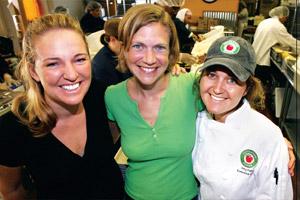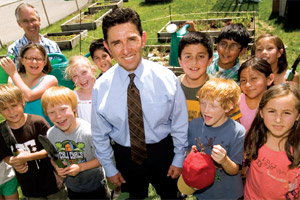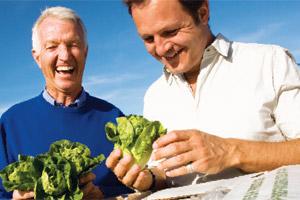In Marin County, Miguel Villarreal, has dedicated himself to educating children, parents and school employees about the benefits of eating locally grown, in-season produce, while a nearby trio of female foodies has launched a healthy-eating crusade of their own.
"Revolution Foods" is an idea hatched by Kristin Richmond and Kirsten Tobey--both business school graduates with backgrounds in education and a shared vision of creating a social venture that would help today's youth.
"After grad school, we both had an interest in food and had this entrepreneurial spirit, but we also wanted to make a difference in our local schools," Tobey recalled. "We saw how bad school lunches were and immediately knew that's where we should start."
The two struck up a friendship with a young and upcoming chef named Amy Klein. The graduate of San Francisco's Tante Marie's Cooking School held a promising position at Insalata's, a gourmet restaurant in San Anselmo, so making school lunches was the last thing on her mind.
"Going from filet mignons to pizzas was a change for sure," Klein said with a chuckle. "But once they explained to me their core belief was that all students should have access to healthy, fresh food on a daily basis, I was hooked."
Together the three came up with a venture to reach kids of all ages, all ethnicities and all economic classes throughout the Bay Area. And in the summer of 2006, Revolution Foods was launched.
Today kids from preschool through high school are enjoying some of Klein's new gourmet masterpieces--beef tacos with Spanish-style brown rice, chicken bites coated with crunchy panko, pizza with Diestel turkey sausage and spaghetti with all-natural beef marinara sauce, served with steamed broccoli.
"I just remember having nachos, chicken nuggets and something that looked like mystery meat for lunch when I was a kid," Klein said. "So when we started coming up with recipes, I wanted kids to know what they were eating. If we served teriyaki chicken, I wanted it to look like chicken. No mystery meat here."
Klein and her staff get the food revolution started each weekday at 3 a.m. sharp at their new headquarters in Oakland. Having outgrown several locations, they now work out of a refurbished McDonald's.
"Pretty ironic, huh?" Richmond said with a smile.
The meals not only meet the state's nutritional guidelines, they're also at least 60 percent organic, the meat and dairy are free of added hormones and antibiotics, and almost all of the packaging is recyclable. In addition, every meal comes with a whole piece of fresh fruit or vegetable.
"We could do the typical fruit cup or something else that is processed with fruit, but that's not what we want," Klein said. "Part of our job is to introduce kids to new foods--new fruits, new vegetables--and give them choices beyond the typical apple or banana."
To source the highest-quality ingredients, the trio found quick partners in companies looking to positively affect the way kids to eat. The Community Alliance With Family Farmers, Whole Foods Market, Clover Stornetta Farms and Diestel Turkey Ranch are four of their main suppliers.
"I think you have to lead by example," said Joan Diestel of Diestel Family Turkey Ranch in Sonora. "The women of Revolution Foods aren't just talking about it. They're out there making a difference. And as these little turkey farmers from Tuolumne County, we're just excited to be a part of it all."
Today the combined effort between the crusaders and the farmers is cranking out more than 12,000 breakfasts, lunches and snacks each day for schools throughout the Bay Area. And the kids couldn't be happier.
At LPS Richmond, a public charter high school in one of the East Bay's grittier sections, kids are literally eating up this new idea of what a school lunch should look and taste like.
"I love the teriyaki chicken. It's the bomb," Angel Johnson said. "And I am in love with their milk."
"It's organic and healthy and it comes straight from the crops, so it's, like, picked in the morning and here for us in the afternoon," Rueben Hernandez said. "I don't eat very healthy, but I like this food."
"I feel more energized by the end of the day," James Willford said. "Before we started eating this food, I would feel like I needed a nap at the end of the day, but not anymore."
Principal Shawn Benjamin says she gets a kick out of seeing her students snacking on fresh fruit.
"They used to come to the office later in the day looking for ice cream or chips," Benjamin said. "Now they ask for a piece of fruit. It's amazing."
This kind of response is fueling the revolution, prompting the women of Revolution Foods to expand their operations into Los Angeles this winter.
"This is just the tip of the iceberg. We feel that the schools and kids are ready for this," Tobey said. "Small introductions to new foods is really what changes eating habits in the long run."
The school garden is just one tool Miguel Villarreal, center, uses to help students improve their health and well-being. He's joined in the garden by Lu Sutton Elementary teacher Thomas Scheaffer, far left, and his third-graders.
Meanwhile, Villarreal is leading his own cafeteria crusade in Marin County by touting the benefits of locally grown, in-season produce--and making sure it's front and center on his menus.
"Almost 100 percent of the fresh fruit I buy is locally grown," said Villarreal, who is director of food and nutritional services and wellness coordinator for the Novato Unified School District. "We as nutritionists know that with produce that just came off the tree or plant, the kids are going getting their highest level of nutrition. As a result, we're seeing greater consumption of fruits and vegetables. So it's not being thrown away. It's going into the students' bodies."
Although he has more than 25 years of experience in nutrition, it wasn't until Villarreal moved to California and recognized the state's extensive agricultural bounty that he decided to change his approach to keeping students healthy. Marin County's rolling hills, coastal bluffs and flat interior valleys were loaded with fruit, vegetables and livestock--the perfect recipe for good student nutrition.
"We've been delivering the same message for 20-plus years, telling people if we don't change the way we're feeding our kids, we're on this track to what we're seeing today," said Villarreal, citing a survey indicating that at least one-third of Marin County children ages 2 to 17 are overweight. "The difference now is people are starting to listen and they're also saying, 'What can I do?'"
For about three years, Villarreal has collaborated with the farmers of Marin Organic as part of a farm-to-school program to supply students in the Novato Unified School District with 4,000 healthy breakfast and lunch meals each day.
"This concept is actually quite simple," said Warren Weber, owner of Star Route Farms in Bolinas, the state's oldest certified organic row crop farm and producer for Marin Organic. "It's just helping kids start having diets that rely more on fresh food and fiber and less on processed foods. In doing that, we're making a connection between our farms and our schools and the larger community."
The partnership between Villarreal and participating farmers is not only a great way to tap into locally grown produce, it also instills in children and their families an awareness of where their food comes from. This is an awareness Villarreal has had since he was 9, when he followed his migrant parents into the agricultural fields of Idaho to harvest vegetables. While he knew early on that working in the fields was not for him, he always felt connected to the land and to food.
Today Villarreal educates young and old alike about the benefits of eating healthfully and reducing obesity and other health challenges. He has replaced vending machines loaded with sodas and junk food with meals that feature a mouthwatering array of fresh fruit and vegetable choices--including vitamin-packed salads, wraps and parfaits.
"I like the salad, carrots and oranges that are served in the school cafeteria," said Krystal Gutierrez, a third-grader at Lu Sutton Elementary School in Novato. "I like the strawberries because they are good and delicious."
Villarreal practices what he preaches. In his role as wellness coordinator, he encourages students to round out their nutrition education with plenty of exercise and by appreciating their environment.
"Providing healthy food is only a part of the health equation," Villarreal said. "We must simultaneously use all of our collaborative partners to educate our students on nutrition and wellness if we're going to make a difference in the health and well-being of our society."
The school garden is one tool used to achieve this. All teachers at Lu Sutton use the garden as a learning center for subjects including science, math and writing. And the school is a shining example that healthy diets equal healthy minds.
Warren Weber, left, owner of Star Route Farms in Bolinas, and Helge Hellberg, executive director of Marin Organic, admire the baby lettuce that Weber grows for school lunches. "The garden is also extremely therapeutic for many students," said third-grade teacher Tom Scheaffer. "They choose to go there at recess and water, plant and transplant and taste our peas, lettuce and other veggies."
While they're pleased with the success their programs have had in changing the way kids eat, the cafeteria crusaders say they'd like legislators to step up to the plate, as it were, to encourage more of these types of endeavors.
"We all make choices in our community--every day in how we support them, whether they're private or public, and this is a way to combine our belief in community activism with our passion for healthy food," Tobey said. "We call it the school lunch revolution and we're proud to be a part of it."
Plan to plant
The trend of garden-based education just keeps, well, growing! If you'd like to start or enhance a school garden, follow these tips from "Farming is Food, Fiber, Flowers... and Fun!," a free workbook on the California Foundation for Ag in the Classroom's Web site.
First, write two or three sentences about how the garden will help your school. Be specific about who will benefit--children (ages, grades and number), senior citizens, families, community and so on.
After you've determined your mission, it's time to create your vision. That is, decide what you'll do in your garden. Will you grow a specialized garden--native plants or an orchard--or a variety of plants? Do you envision drip irrigation, a tool shed or covered outdoor classroom? This is your dream garden, so be creative. The next step is to draw your garden to incorporate all desired elements. Label each area and make detailed notations about them.
From here onward, you and your garden will need lots of support--financial, physical and moral. If you take the time to build a strong foundation of key contacts, they will become partners and champions of your garden project. Potential supporters include your school principal, county office of education, district maintenance supervisor, county master gardener, PTA/PTO representative and parent/student volunteers.
Tracy Sellers and Christine Souza are reporters for the California Farm Bureau Federation. They can be reached at 800-698-FARM or tsellers@cfbf.com or csouza@cfbf.com. 





